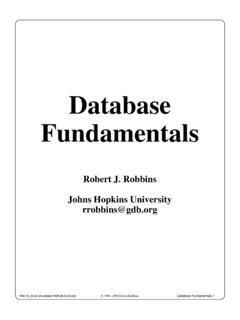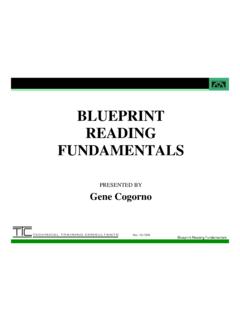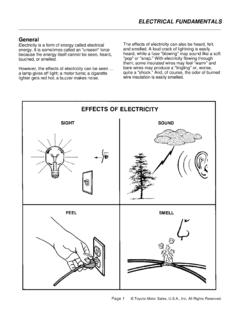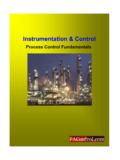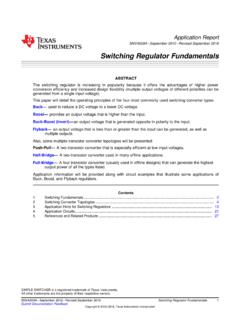Transcription of White Paper: Fundamentals of Orifice Meter …
1 White PaperFebruary 2017 - Page 1 Fundamentals of Orifice Meter measurement This White paper provides an overview of Orifice Meter technology, its advantages and general installation recommendations, as well as describes basic gas flow laws and the variables of Orifice Meter flow equations. White PaperFundamentals of Orifice Meter MeasurementFebruary 2017 - Page 21 Overview 2 Overview of Orifice Meter Technology3 How an Orifice Meter Works 4 History of Orifice Flow Measurement5 Gas Law Fundamentals6 Orifice Gas Flow Equation 7 Critical Flow 8 Major Advantage of Orifice Meter Measurement9 The Three R s 10 The Orifice Plate11 Meter Tap Location12 Primary Element Orifice Flanges13 Dual-Chamber Orifice Fitting14 Single-Chamber Orifice Fittings15 Meter Tubes16 Visual Manometers17 Differential Pressure (DP) Cells18 Daniel Senior Orifice Fitting19 Daniel Junior Orifice Fitting20 Daniel Simplex Orifice Plate Holder 21 Daniel Orifice Meter TubesList of FiguresTable of Content355 667101011121516161616171718181919 Pressure Loss Characteristics of Primary DevicesTypical Orifice Flow Pattern Flange Tap Diagram Thin Plate.
2 Concentric Orifice Eccentric Orifice PlateSegmental Orifice PlateQuadrant Edge PlateConic Edge PlatePressure Tap LocationsTypical Meter Tube with an Installed Orifice FittingDaniel SeniorTM Orifice FittingDaniel JuniorTM Orifice FittingDaniel SimplexTM Orifice Plate Holder1 2 3 4 5 6 7 8 9 10 11 12 4 5 12 13 13 1414 1517181819 White PaperFundamentals of Orifice Meter MeasurementFebruary 2017 - Page 31. OverviewFluid meters are divided into two functional groups: one measures quantity (positive displacement) and the other measures rate of flow (inferential). All fluid meters consist of two distinct parts, each of which has a different function to perform. The first part is the primary element which is in contact with the fluid, resulting in some form of interaction.
3 This interaction may be that of imparting motion to the primary element ( the fluid may be accelerated, etc.). The second part is the secondary element that translates the interaction between the fluid and primary element into a signal that can be converted into volume, weight or rate of flow. The device then indicates or records the results. With an Orifice Meter , the Orifice together with the adjacent part of the pipe and the pressure connections constitute the primary element. The secondary element consists of a differential pressure device together with a mechanism that translates the pressure difference into a rate of flow and indicates the result. In some cases, the device also records the result graphically and integrates the data with respect to time. This combination of primary and secondary elements is typical in most types of fluid meters , Positive Displacement (quantity meters )Common types of positive displacement meters include reciprocating piston, rotating piston, nutating disk, sliding and rotating vanes, and gear and lobed impeller.
4 The Meter most commonly used to sell small quantities of natural gas at relatively low flow rates is known as the bellows Meter . Inferential (rate meters )There are many types of inferential meters available, Orifice Plates The most commonly used inferential or rate Meter is the thin-plate, concentric Orifice Meter which is the primary device discussed in this paper. Flow Nozzles and Venturi Tubes Flow nozzles and Venturi tubes are primary rate devices which will handle about 60% more flow than an Orifice plate for the same size bore under the same conditions, enabling these devices to handle higher velocity flows. If a differential pressure limit is chosen, a smaller bore nozzle or Venturi may be used to measure flow under the same conditions. These devices are more expensive to install and, due to their size, are not as easy to change or inspect as Orifice plates. Pitot Tubes A pitot or impact tube accounts for the difference between static and kinetic pressures at a single point.
5 A similar device, the averaging pitot tube is, in effect, White PaperFundamentals of Orifice Meter MeasurementFebruary 2017 - Page 4a multi-point pitot tube that averages the flow profile. Turbine meters A turbine Meter has a primary element that is kept in rotation by the linear velocity of the flow in which it is immersed. The number of revolutions the device makes is proportional to the actual volume of flow. Vortex Shedding meters Vortex meters use a bluff body to create vortices with the frequency of the vortices directly proportional to flow Magnetic Resonance meters Magnetic resonance meters , also known as mag meters , operate on the principal of induction. By surrounding a conductive liquid with a magnetic field, movement of the liquid creates a measureable signal proportional with flow Coriolis meters These meters use the Coriolis effect to measure mass flow rate Other Meter TypesOther devices that have applications in flow measurement include swirlmeters and rotameters.
6 Permanent Pressure LossThe amount of unrecovered loss due to a flow element is known as permanent pressure loss. For differential pressure elements, the calculation of pressure loss is straightforward. The total system pressure loss should be based on the amount of differential created at a given beta ratio for a given flow. Devices with a lower coefficient of discharge may not necessarily have a lower permanent loss for the same flow. Figure 1: Pressure Loss Characteristics of Primary Devices0 with Flange TapsFlow NozzleShort Cone Venturi Long Cone VenturiLo-Loss Tubesd/D Ratio (Beta)% Permanent Pressure LossWhite PaperFundamentals of Orifice Meter MeasurementFebruary 2017 - Page 52. Overview of Orifice Meter TechnologyA differential pressure Meter creates a pressure drop by combining a conduit and a restriction. A nozzle, Venturi or thin, sharp-edged Orifice can be used as the flow restriction.
7 Prior to using any of these devices for measurement , it is necessary to empirically calibrate them by passing a known volume through the Meter and noting the reading to provide a measurement standard for other quantities. Due to the ease of duplication and the simple construction, the thin, sharp-edged Orifice has been adopted as a measurement standard. Extensive calibration work has also been performed on the device, making it widely accepted as a standard means for measuring fluids. Provided the standard mechanics of construction are followed, no calibration is required. An Orifice installed in a pipeline along with a manometer for measuring the drop in pressure (differential) as the fluid passes through the Orifice is shown in Figure 2. The minimum cross-sectional area of the jet immediately after the Orifice is known as the vena contracta. 3. How an Orifice Meter Works As fluid approaches the Orifice , the pressure increases slightly and then drops suddenly as the fluid passes through the Orifice .
8 The pressure continues to drop until it reaches the vena contracta and then it gradually increases until it is approximately 5D to 8D. At this point, it reaches maximum downstream pressure which is lower than the pressure upstream of the Orifice . The pressure decrease as fluid passes through the Orifice is due to the increased velocity of the natural gas passing through the reduced area of the Orifice . When the velocity decreases as the fluid leaves the Orifice , the pressure increases and tends to return to its original level. The pressure loss is not fully recovered due to loss of friction and turbulence in the stream. The pressure drop P1 Differential P(P1 - P2)PermanentPressure Loss(P1 - P3)P2P3 Figure 2: Typical Orifice Flow Pattern Flange Tap DiagramWhite PaperFundamentals of Orifice Meter MeasurementFebruary 2017 - Page 6 The first recorded use of an Orifice device for fluid measurement was in 1797 by Giovanni B.
9 Venturi, an Italian physicist whose work led to the development of the modern Venturi Meter in 1886 by Clemons Herschel. In 1890, it has been reported that an Orifice Meter designed by Professor Robinson of Ohio State University was used to measure gas near Columbus, Ohio. In 1903, Weymouth began a series of tests in Pennsylvania leading to the publication of coefficients for Orifice meters with flange taps. At the same time, Hickstein conducted a similar series of tests at Joplin, Missouri from which he developed data for Orifice meters with integrated pipe taps. From 1924 to 1935, a significant amount of research and experimental work was conducted by the American Gas Association (AGA) and the American Society of Mechanical Engineers (ASME) that resulted in the development of Orifice Meter coefficients and standards of construction for Orifice meters . In 1935, a joint AGA-ASME report was issued, History of Orifice meters and The Calibration, Construction, and Operation of Orifices for Metering that remains as the basis for most present day Orifice Meter measurement installations.
10 In early 1991, the American Petroleum Institute (API) issued an updated version of this standard based on new data titled, Manual of Petroleum measurement Standards, Chapter 14, Section 3, Parts 1-4. Several additional publications are available to simplify measurement by Orifice meters , including ASME Fluid meters 6th Edition, ASME Power Test Code, Chapter 4 on Flow measurement and The Flow measurement Engineering Handbook by Miller. All matter is composed of exceedingly tiny particles called molecules. A molecule is defined as the smallest particle that can exist in a free and undecomposed state ( , natural gas is composed of molecules of methane, ethane, etc.). These molecules are in constant motion and it is the impact of these molecules on the sides of a container that is measured as pressure. Temperature regulates the speed of the molecules. Therefore, an increase in temperature increases the motion of the molecules which increases the pressure in a constant volume , the motion of the molecules will decrease as temperature and pressure decrease.










